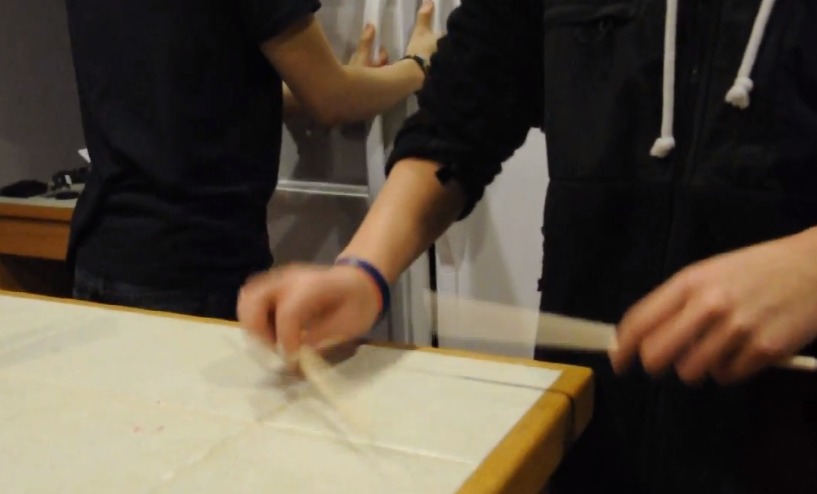Drum a beat
Build a simple drum kit from household items (pots, boxes, wooden spoons) and practice steady beats and rhythm counting to learn basic percussion.



Step-by-step guide to build a simple drum kit from household items and practice steady beats
How to play the Drums (beginner lesson) | Andy and the Band Tutorial | CBBC
Step 1
Gather all the materials and bring them to a clear space on the floor or a table.
Step 2
Put the cushion or towel down to protect your floor or table under your drum kit.
Step 3
Place the large pot the small pot and the cardboard box in front of you to make your drum layout.
Step 4
Stretch cling film tightly over the top of the cardboard box and secure it with rubber bands or tape to make a drumhead.
Step 5
Put the metal lid next to your pots to act as a cymbal.
Step 6
Pick up two wooden spoons to use as your drumsticks.
Step 7
Tap the large pot once evenly four times to make a steady beat.
Step 8
Say the numbers "1 2 3 4" out loud in time with each tap to practice counting the rhythm.
Step 9
Play a simple pattern by hitting the large pot on beats 1 and 3 and the small pot on beats 2 and 4 slowly.
Step 10
Add a cymbal accent by tapping the metal lid gently on the last beat of each four count.
Step 11
Share a photo or video of your drum kit and your rhythm practice on DIY.org
Final steps
You're almost there! Complete all the steps, bring your creation to life, post it, and conquer the challenge!


Help!?
What can I use if I don't have cling film, rubber bands, or a metal lid?
Stretch a thin piece of cardboard or a popped balloon taped over the cardboard box and secure it with string or tape instead of cling film and rubber bands, and use a saucepan lid or large jar lid as the metal cymbal.
My cling film drumhead keeps sagging and the pots slide — how can I fix that?
Re-stretch the cling film tightly over the box and add extra rubber bands or tape under the rim, and put the pots on the cushion or a non-slip mat (or a bit of double-sided tape) so they don't move when you tap.
How can I adapt this drum beat activity for younger or older children?
For younger kids let them use hands instead of wooden spoons and focus on tapping the large pot while counting '1 2 3 4,' while older kids can play the 1-and-3/2-and-4 pattern faster, add the cymbal accent on the metal lid, or create more complex rhythms and record a video.
What are some ways to personalize or extend the drum kit activity?
Decorate the pots and cardboard box, tune pots by adding different amounts of water for varied pitches, make a shaker with a small container and dried rice, or write and practice a two-bar rhythm that includes the cymbal accent before sharing a photo or video on DIY.org.
Watch videos on how to build a simple drum kit from household items and practice steady beats
CBeebies | Do You Know? | How to make a drum
Facts about percussion and rhythm for kids
🥁 Drums are some of the oldest musical instruments — people have been playing drums for thousands of years!
🕒 Most beginner beats are counted in 4 (1-2-3-4), which makes it easy to keep a steady rhythm.
🧠 Practicing steady beats with a homemade kit helps improve coordination, timing, and concentration.
👂 Tempo (the speed of the beat) is measured in BPM — a slow song can be ~60 BPM and a fast one 120 BPM or more.
🍳 You can turn pots, boxes, and wooden spoons into a drum kit — street drummers often play on buckets and household items!
How do you build and use a simple homemade drum kit to teach steady beats?
What materials do I need to build a simple drum kit from household items?
What ages is this drumming activity suitable for?
What are the benefits, safety tips, and variations for practicing steady beats and rhythm counting?


One subscription, many ways to play and learn.
Only $6.99 after trial. No credit card required

![FL Studio 12 - How to Make Beats [Beatmaking Tutorial]*](https://img.youtube.com/vi/FExdEUz1-qo/mqdefault.jpg)

![FL Studio 11 - How to Make a Beat [Beat Making Tutorial]](https://img.youtube.com/vi/x4XkQtpyWxM/mqdefault.jpg)